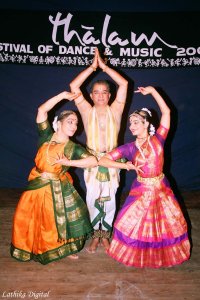
A peep into
the aesthetics of Bharatanatyam
- Padma Jayaraj,
Thrissur
e-mail: padma.jayaraj@rediffmail.com
November 4,
2005
 Guru
Dhananjayan and his wife Shanta Dhananjayan came home to perform in the
cultural capital of Kerala under the aegis of Thalam, a cultural organization
that proudly welcomed them. Both of them graduated from Kalakshetra and
made Chennai their karma bhoomi by establishing their dance school Bharata
Kalanjali. They have also founded another institution, Bhaaskara in Payyannur,
in Kerala, for promoting Carnatic music and Bharatanatyam. Guru
Dhananjayan and his wife Shanta Dhananjayan came home to perform in the
cultural capital of Kerala under the aegis of Thalam, a cultural organization
that proudly welcomed them. Both of them graduated from Kalakshetra and
made Chennai their karma bhoomi by establishing their dance school Bharata
Kalanjali. They have also founded another institution, Bhaaskara in Payyannur,
in Kerala, for promoting Carnatic music and Bharatanatyam.
The Dhananjayans
perform with a rare togetherness, born out of years as a dancing couple.
For them realization of art is both a philosophy and religion. With a team
of accompanists who have made their mark in their respective fields, the
evening had a traditional aura. They began the performance with the customary
Ganesha Vandanam "Mooshika vahana," in natta raga set to adi tal.
Krishna is
enshrined as Guruvayoorappan in the popular heart of Kerala. And the Dhananjayans
knew the pulse of their heartland. So, the second item was "Manasa sancharare......"a
poem by Sadasiva Brahmachandra in Syama raga, set to adi tal, a unique
piece. The choreography visually rendered devotion at three levels, physical,
mental and spiritual. The singer played on the tender emotions of a Krishna
consciousness while the dancer portrayed the untold adorations that thrilled
the hearts of the devotees of Krishna. The charms of Krishna from cradle
to power dominated the themes. Krishna the leader of Yadavas towered in
glory, but was humane in compassion. The choreography crystallized into
a Krishna, not as a mythical hero but the embodiment of full-fledged human
glory in an inspiring dimension, the making of an ideal leader. Here is
the prototype to which we can always return when we lack models in real
life, especially when our rulers fail us.
"Mohana Krishna....."
in raga mohanam, adi tal was a pada varnam by Divya Sivasundar, a disciple
of the Dhnanjayans. Once again the audience feasted on Krishna stories
flashed across their mental vision as the dancer gave fleeting glimpses
of tales told umpteen times over centuries by Indian artists, tales that
remain ever fresh and ever new in an aura of romance. "This is a nrityopahara......"
explained the Guru, "a combination of pure dance, drama and a rendering
through the medium of expression of both facial and body movements." At
a time when we long for young talent, Divya came as a dream, a young vivacious
dancer performing an unforgettable impassioned item.
The next item
took the audience to aesthetic heights. An episode from the Ramayana, a
scene crystallized in the popular mind came in superb dramatic form in
ragamalika and thala malika. On the eve of the coronation of Rama, a contented
happy Kaikeyi is blissfully asleep. There comes the hunchback, Mandhara
who poisons her mind. The evil that sleeps buried in human mind surfaces
coupled with the fear of an unknown future and loss of power. Kaikeyi is
just a gullible woman and the likes of Mandhara are virulent among human
beings. The king, who feels his life's mission is almost over, comes to
his dearest partner who has shared his travails and triumphs. Instead of
peace, what awaits him are traps unsuspected. Trapped by his own promises,
the king feels devastated. Banish his glorious son to the wild......???
"Has all reason gone mad......!!" The music stops......time stands still,
silence marks the witness......the shattered king falls dead at the feet
of his onetime beloved queen...... banished from life for ever......
It is the
humanization of the mythical that makes Dhananjayan's choreography enchanting
and unique. The positive and the negative are brought out in human dimensions.
Somewhere we realize that we too are like them if caught in similar situations,
that the evil is no longer black but gray, that they are close to us and
not far removed in times long lost.
Guru Dhananjayan
showed without a change in the costume, how a performer could play different
roles using just body language and facial expression. He donned the roles
of both Mandhara and King Dasaratha. If Mandhara is a scum on the borderline
of ignoble humanity, the king is a perfect man, regal in every ounce. Yet
when he falls dead, what a fall it is. His wife Shanta played Kaikeyi.
When the beautiful
evening ended with a thillana in raga bihag, the audience gave a standing
ovation. They felt both happy and sad: sad because an outstanding show
ended, happy because they got a peep into the aesthetics of Bharatanatyam,
something rare.
Padma Jayaraj is a regular
contributor to narthaki.com
|

